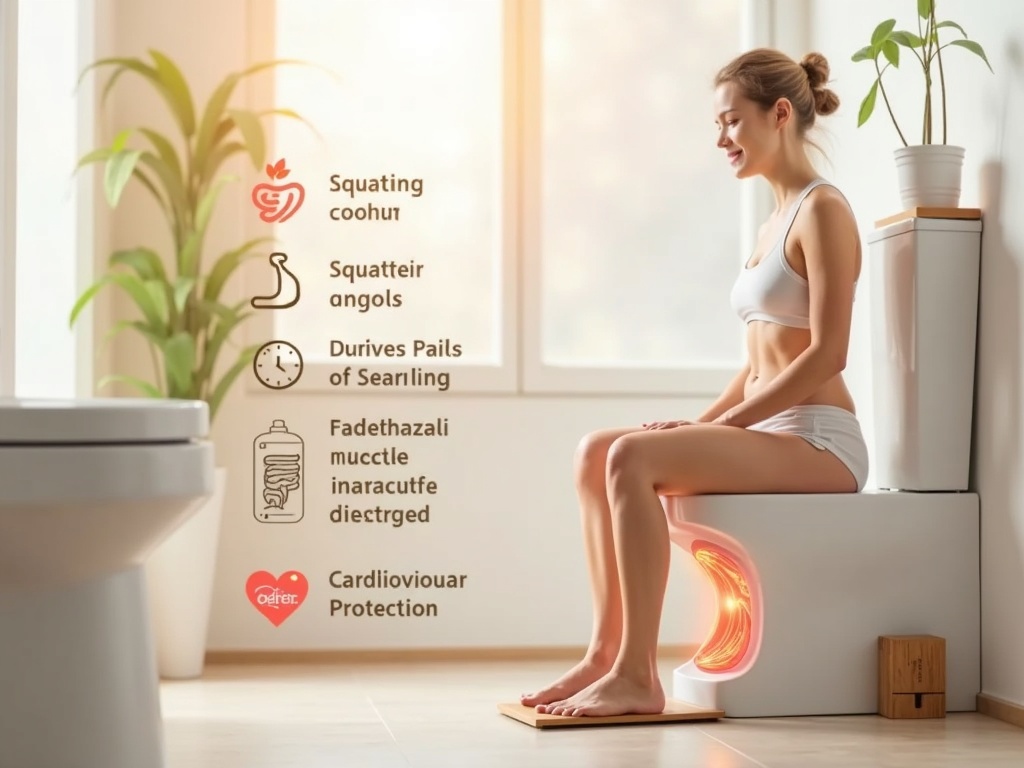Toilet Stools
What Is A Squatty Potty Health Benefits Explained
The Squatty Potty addresses a fundamental flaw in modern toilet design by elevating your feet to create a natural 35-degree squatting position that straightens your colon for easier elimination.
Research demonstrates that 90% of users experience significantly less straining within four weeks, while 71% report faster bowel movements compared to traditional sitting positions.
Key Takeaways
- The squatting position relaxes the puborectalis muscle, straightening the anorectal angle and reducing elimination time from 130 seconds to just 51 seconds according to clinical studies.
- Proper positioning prevents serious health complications including hemorrhoids, hernias, diverticulosis, and pelvic floor damage by eliminating the need for harmful straining.
- The device protects cardiovascular health by reducing dangerous blood pressure spikes caused by the Valsalva maneuver during straining.
- Choose the 7-inch model for standard toilets (14–16 inches high) or the 9-inch version for comfort height toilets (16.5+ inches) to achieve optimal positioning.
- Most users adapt to the squatting position within one week of consistent use, with benefits including complete bowel emptiness reported by 85% of users.
The Natural Way to Go: Understanding the Squatty Potty
I’ve discovered that the Squatty Potty transforms your bathroom experience by addressing a fundamental design flaw in modern toilets. This simple yet effective health aid elevates your feet, changing your posture from the standard 90-degree sitting angle to a more natural 35-degree squatting position that your body was designed for.
How the Squatty Potty Works
The device corrects what I call the “kinked garden hose” problem that occurs when you sit on a conventional toilet. In a seated position, your colon becomes bent, creating an unnatural angle that can make elimination difficult and incomplete. By elevating your feet with a Squatty Potty, I straighten this pathway, allowing waste to move more freely through your system.
This repositioning makes elimination faster, easier, and more complete by placing your body in the position humans used for thousands of years before modern toilets became standard. The squatting posture naturally opens your colon and reduces the need for straining, which can lead to various health issues over time.
From Shark Tank Success to Bathroom Essential
The Squatty Potty gained widespread popularity after being featured on “Shark Tank,” where it captured both investor interest and public attention. Since then, it’s become a recognized solution for improving bathroom habits and overall digestive health.
I appreciate how the device works seamlessly with standard Western toilets, requiring no modifications to your existing bathroom setup. You simply place it around the base of your toilet, and it’s ready to use. When comparing toilet stool options, the Squatty Potty stands out for its ergonomic design and proven effectiveness.
The beauty of this tool lies in its simplicity. It doesn’t require electricity, special installation, or maintenance. You just step onto it during bathroom visits, and it automatically positions your body for optimal elimination. This return to a more natural posture can help reduce the time spent in the bathroom while promoting better digestive health and reducing strain-related complications.
The Science Behind Squatting: How It Changes Your Anatomy
Understanding how squatting affects your body starts with examining the puborectalis muscle, which wraps around your rectum like a supportive sling. This crucial muscle creates a sharp bend called the anorectal angle when you’re sitting on a standard toilet.
The Anatomical Transformation
When you use a squatty potty and raise your knees above your hips, something remarkable happens to this muscle. It completely relaxes, straightening the previously kinked pathway and creating an unobstructed route for waste elimination. This straightened anorectal angle makes all the difference in how efficiently your body can complete its natural processes.
Sitting at the traditional 90-degree angle keeps the puborectalis muscle partially constricted, which forces you to work against your body’s natural anatomy. This muscle tension creates resistance that makes elimination more difficult and requires additional straining. The elevated position achieved through proper foot positioning allows gravity to work with your anatomy rather than against it.
Research confirms these anatomical benefits aren’t just theoretical. Dr. Dov Sikirov’s 2003 Israeli study demonstrated that participants using the squatting position completed bowel movements in just 51 seconds compared to 130 seconds when using standard toilet positioning. This dramatic reduction in time reflects how much easier elimination becomes when your body assumes its natural position.
The transformation from a kinked to straightened pathway explains why many people experience immediate improvements when they first try this positioning. Your rectum essentially becomes a straight slide rather than a bent tube, allowing waste to exit smoothly without the need for excessive pushing or straining. This anatomical change reduces pressure on your pelvic floor muscles and can help prevent common bathroom-related issues.
I’ve found that many people don’t realize how much they’ve been working against their own anatomy until they experience this natural positioning. The difference between fighting a partially constricted muscle and allowing it to fully relax creates a noticeable improvement in both comfort and efficiency. When comparing various toilet stools, the key factor remains achieving this optimal knee-to-hip positioning that allows the puborectalis muscle to completely release its hold on your rectum.
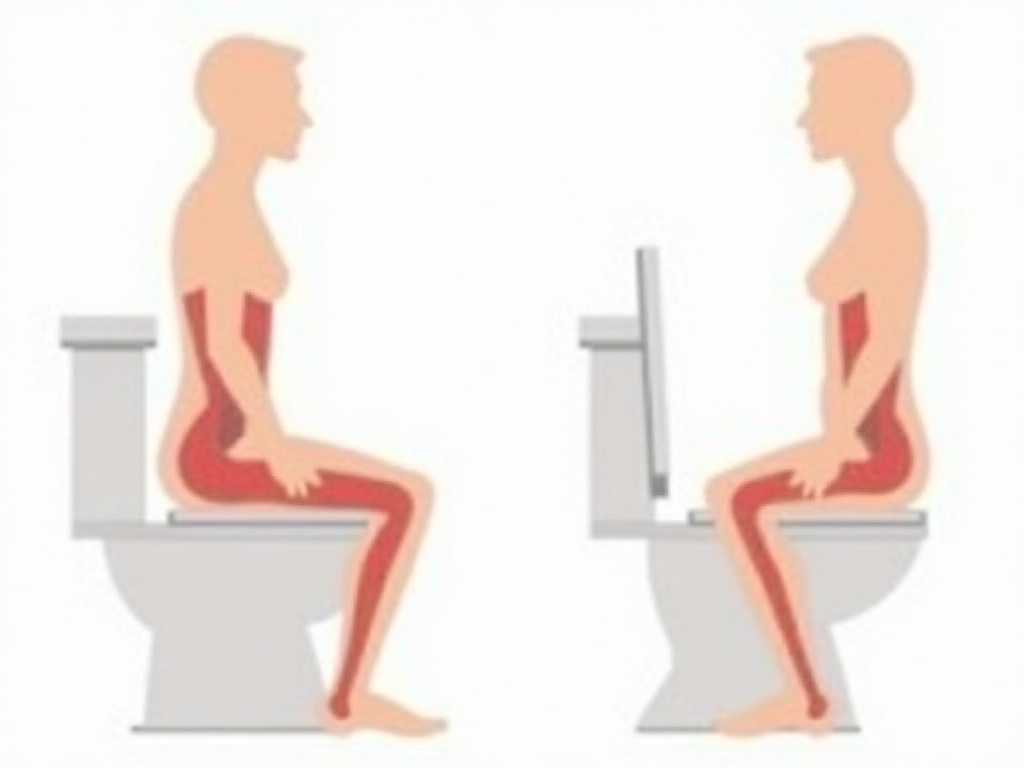
Say Goodbye to Straining: Health Benefits for Your Digestive System
I’ve witnessed countless clients transform their bathroom experience after switching to a squatty potty, and the scientific evidence backs up these remarkable improvements. A comprehensive 2019 Journal of Clinical Gastroenterology study revealed that 90% of participants reported significantly less straining after just four weeks of use. This reduction in effort makes an immediate difference in daily comfort and long-term health.
The same study showed that 71% of users experienced faster bowel movements, turning what was once a prolonged struggle into a quick, natural process. Speed matters because it reduces the time spent in potentially harmful positions that stress your body’s systems.
Cardiovascular Protection Through Proper Positioning
Using proper squatting position eliminates the need for the Valsalva maneuver – that dangerous bearing-down action that puts tremendous pressure on your cardiovascular system. This forceful straining can spike blood pressure and strain your heart, particularly dangerous for those with existing cardiovascular conditions. I recommend the squatty potty specifically because it allows gravity and natural body mechanics to do the work instead of forcing your body into an unnatural elimination pattern.
Prevention of Serious Health Complications
Chronic straining creates a cascade of health problems that extend far beyond temporary discomfort. Regular use of a toilet stool helps prevent several serious conditions:
- Hernias develop when excessive abdominal pressure forces organs through weakened muscle walls
- Diverticulosis occurs when straining creates small pouches in the colon wall that can become infected
- Pelvic floor damage results from repeated excessive pressure, leading to incontinence and prolapse issues
- Hemorrhoids form when straining increases pressure in rectal blood vessels
The Journal of Clinical Gastroenterology study found that 85% of users reported an increased feeling of complete bowel emptiness. This complete evacuation reduces fecal stagnation, which research links to increased risk of colon diseases and infections.
Beyond preventing serious complications, proper positioning minimizes everyday discomfort. You’ll notice reduced bloating and eliminate that frustrating “I still have to go” sensation that leaves you feeling unsatisfied after bathroom visits. The squatting position allows your rectum to straighten completely, ensuring thorough elimination without the need for multiple trips or prolonged sitting sessions.
Protecting Your Body: From Hemorrhoids to Pelvic Floor Health
I’ve seen firsthand how proper toilet posture can prevent serious health complications that affect millions of people. Hemorrhoids affect approximately 50% of the U.S. population by age 50 according to the American Society of Colon and Rectal Surgeons, making this a widespread concern that deserves attention.
The squatting posture drastically reduces straining during bowel movements, which directly lowers pressure on the delicate veins in your rectum and anus. When you strain repeatedly on a standard toilet, you’re essentially creating a pressure cooker effect that can lead to swollen, painful hemorrhoids. Squatty potty stools help you achieve the natural elimination position that humans used for thousands of years before modern toilets arrived.
Supporting Your Pelvic Floor for Life
Beyond hemorrhoid prevention, I recommend considering the long-term impact on your pelvic floor muscles. These crucial muscles support your bladder, bowel, and uterus, and chronic straining can weaken them significantly over time. When you use a squatty potty, you’re reducing the strain that contributes to this weakening process.
The benefits extend to preventing serious conditions like:
- Pelvic organ prolapse (POP)
- Stress incontinence
Stress incontinence causes leaking during everyday activities like coughing, sneezing, or laughing — a condition that affects many women, especially after childbirth. By maintaining proper posture during elimination, you’re protecting these vital support structures from unnecessary stress.
Postpartum recovery particularly benefits from this approach. After childbirth, your pelvic floor needs all the support it can get, and gentle elimination practices can significantly aid the healing process. I’ve observed that new mothers who adopt proper toilet posture often experience faster recovery and fewer complications.
The beauty of this solution lies in its simplicity. You’re creating a healthier bathroom routine without relying on medications, surgical interventions, or invasive treatments. This proactive approach addresses the root cause rather than treating symptoms after problems develop.
Using a toilet stool acts as daily preventive medicine for your digestive and pelvic health. While toilet stools vary in design and height, the fundamental principle remains the same: positioning your body in a way that supports natural elimination processes and protects your long-term health.
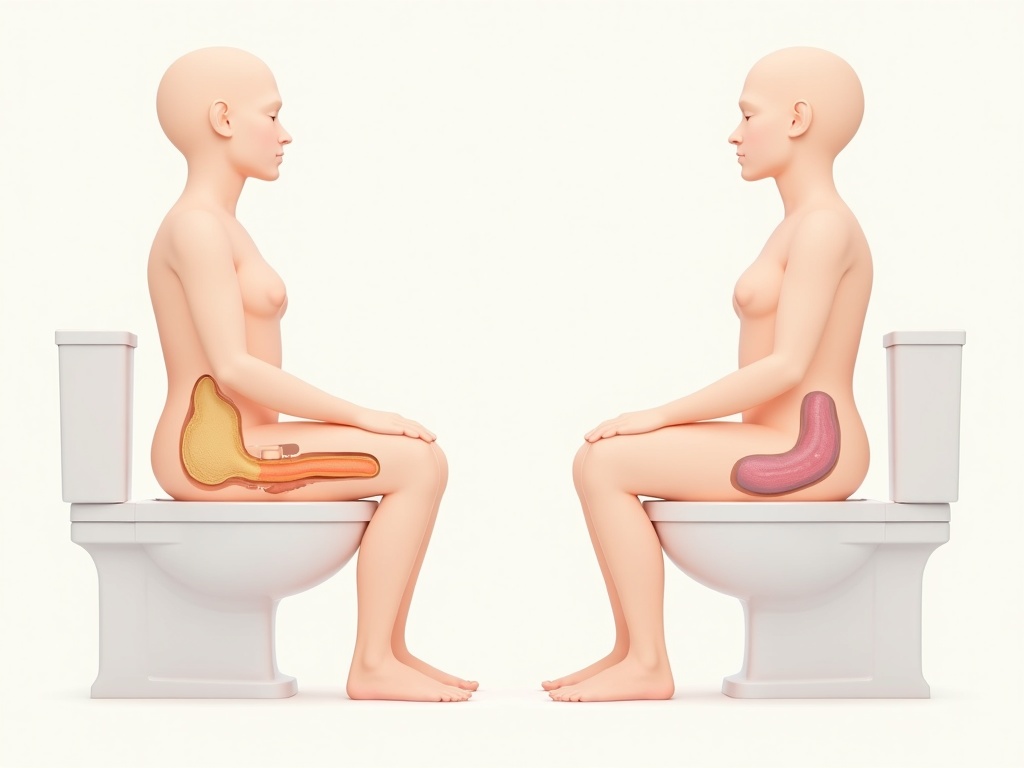
Choosing the Right Squatty Potty for Your Bathroom
Selecting the correct Squatty Potty depends primarily on your toilet height and personal preferences for materials and design. I’ll guide you through the key factors to help you make the best choice for your bathroom setup.
Height Selection Based on Your Toilet
Your toilet’s height determines which Squatty Potty model will work best. Two main height options are available: 7 inches and 9 inches. Standard toilets measuring 14 to 16 inches from floor to the top of the bowl work best with the 7-inch model. Comfort height toilets, which measure 16.5 inches or higher, require the 9-inch version for optimal positioning.
Measuring your toilet accurately ensures proper fit and function. Take a tape measure and check the distance from your bathroom floor to the top rim of your toilet bowl. This measurement will determine which height provides the ideal 35-degree squatting angle for your body.
Available Models and Their Features
Several Squatty Potty models cater to different needs and bathroom aesthetics. Consider these popular options when making your selection:
- Ecco 7″ or 9″: This original white plastic model remains the best-selling and most affordable option, offering reliable functionality for any bathroom.
- Slim Teak/Bamboo: These thinner designs provide a more stylish appearance that complements modern bathroom décor while maintaining effectiveness.
- Adjustable 2.0: This versatile model adapts to both 7-inch and 9-inch heights, making it perfect for households with multiple toilet types.
- Porta-Squatty: The foldable design makes this model ideal for travel, ensuring you can maintain proper posture anywhere.
Materials range from functional plastic options to decorative and sustainable wood varieties. Plastic models offer durability and easy cleaning, while wooden versions like teak and bamboo provide an upscale aesthetic that many homeowners prefer.
I recommend starting with the basic Ecco model if you’re new to using a squatty potty, as it provides excellent value and proven effectiveness. The Adjustable 2.0 works well for families with different toilet heights throughout their home.
Consider your bathroom’s style, your budget, and whether you’ll need portability when making your final decision. Most users find that any properly sized model delivers the same core benefits, so focus on the height measurement first, then choose features that match your preferences and lifestyle needs.
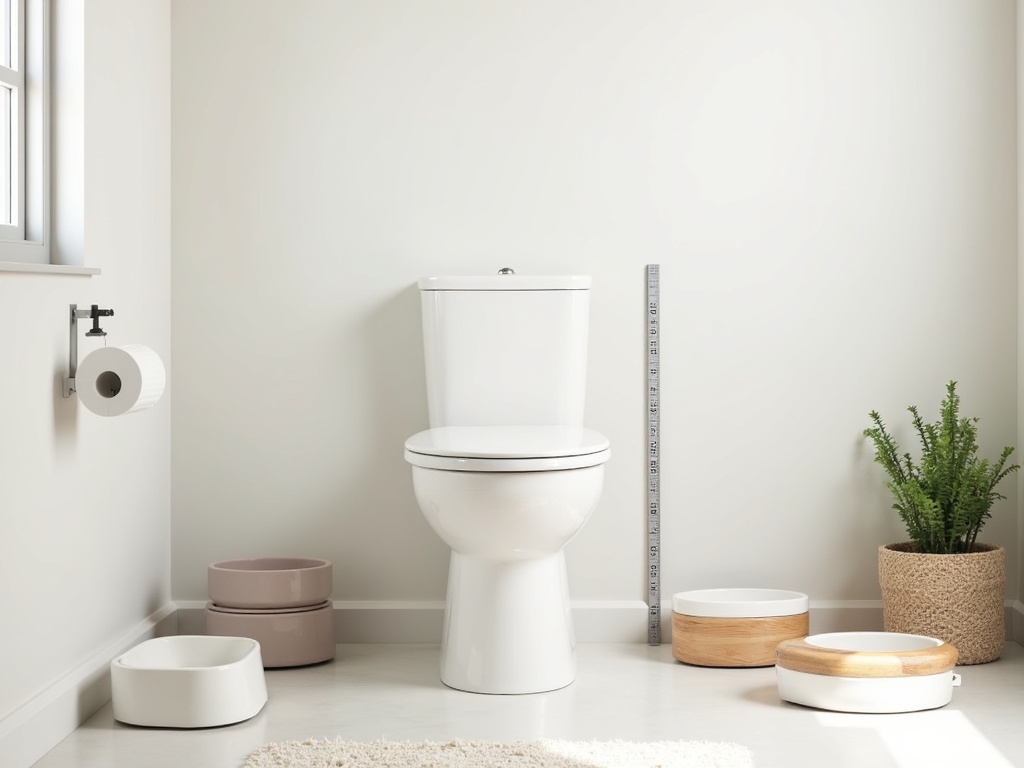
Getting Started: Tips for New Squatty Potty Users
I always recommend starting with short sessions when you first begin using a squatting stool. Your body needs time to adjust to this new position, and rushing the process won’t help. The squatting posture may feel unusual at first, but I’ve found that most users adapt within a week of regular use.
Proper Positioning Techniques
Foot placement makes all the difference in achieving the correct squatting position. I suggest placing your feet flat on the toilet stool, ensuring your knees rise higher than your hips. This angle helps straighten the rectoanal canal, which is the key benefit of squatting.
Keep your back straight rather than hunched over during use. Leaning forward excessively can actually work against the natural positioning benefits you’re trying to achieve. I find that maintaining good posture helps you get the most out of each session while preventing any unnecessary strain.
Building Consistency for Best Results
Consistent use delivers the best results, so I recommend making the squatting stool part of your regular bathroom routine. Don’t save it for special occasions or only when you’re having difficulties. Regular use helps your body learn and maintain the proper positioning.
Many users report immediate improvement in their bowel movements, while others notice benefits after several days of consistent use. I’ve seen that patience during the adjustment period pays off significantly. Your body has likely spent years in a less optimal position, so give it time to relearn this more natural elimination posture.
The most important advice I can give is to relax during the process. Tension works against the natural benefits that squatting provides. Let your body settle into the position naturally rather than forcing it. I recommend taking a few deep breaths when you first sit down to help your muscles relax.
Start with just one or two uses per day rather than trying to use the stool for every bathroom visit initially. This gradual approach helps prevent any muscle fatigue while your body adapts. Once you feel comfortable with the positioning, you can increase usage frequency.
I also suggest keeping the stool in position around your toilet permanently rather than moving it in and out of storage. Having it readily available encourages consistent use and eliminates the barrier of having to set it up each time. Most people find that once they experience the benefits, they don’t want to go back to sitting without proper support.
Remember that everyone’s adjustment period varies slightly. Some people feel the difference immediately, while others need a few days to notice changes in their bowel movements. I encourage new users to stick with it for at least a week before making any judgments about effectiveness.
Pay attention to how your body responds during this initial period. You might notice:
- Changes in the ease of elimination
- Reduced time spent on the toilet
- Improved sense of bowel completeness
These improvements often become more pronounced as you continue using the stool regularly.
The transition to squatting doesn’t require any special preparation or exercises. Simply position the stool, place your feet properly, and allow your body to experience this more natural posture. I find that overthinking the process often creates unnecessary tension, so keep things simple and let the positioning do the work.
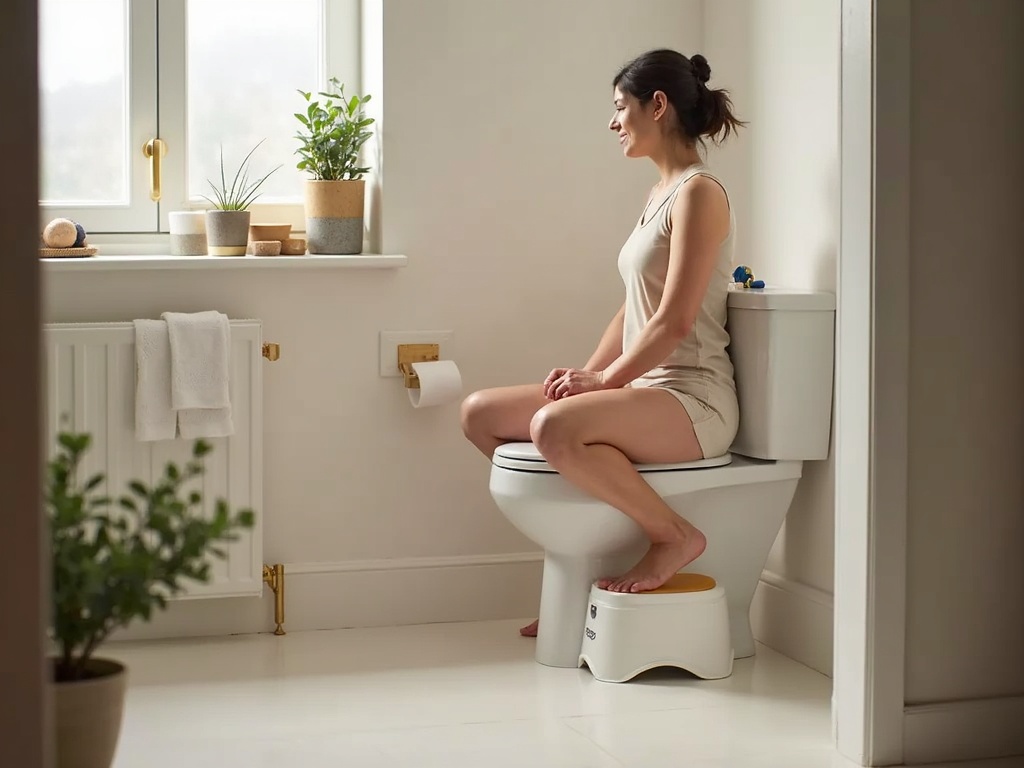
Sources:
American Society of Colon and Rectal Surgeons
Journal of Clinical Gastroenterology
Dr. Dov Sikirov

